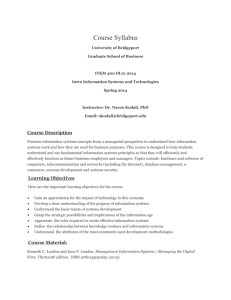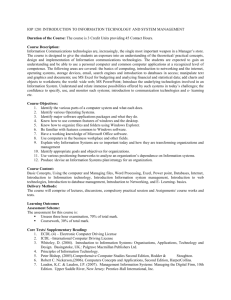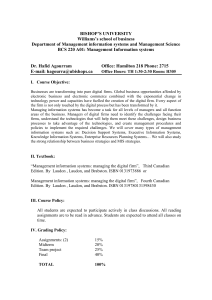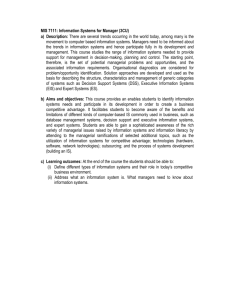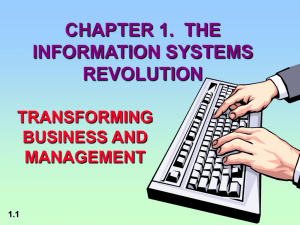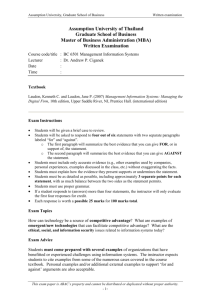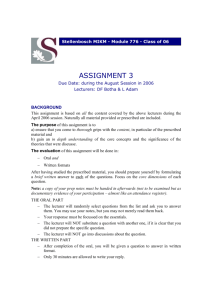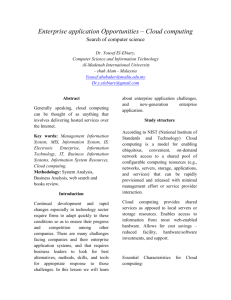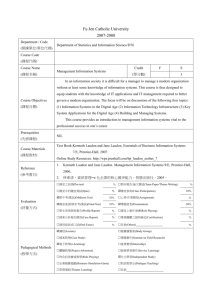Case Study for Information Management (資訊管理個案)
advertisement
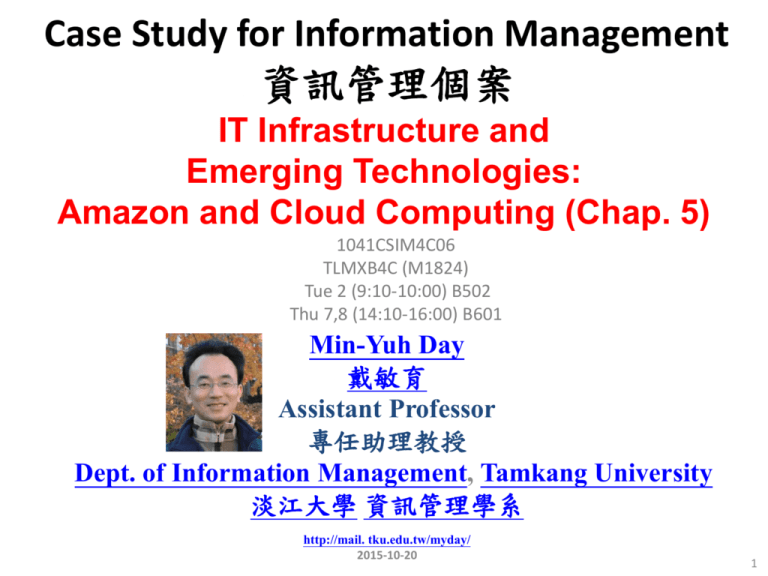
Case Study for Information Management 資訊管理個案 IT Infrastructure and Emerging Technologies: Amazon and Cloud Computing (Chap. 5) 1041CSIM4C06 TLMXB4C (M1824) Tue 2 (9:10-10:00) B502 Thu 7,8 (14:10-16:00) B601 Min-Yuh Day 戴敏育 Assistant Professor 專任助理教授 Dept. of Information Management, Tamkang University 淡江大學 資訊管理學系 http://mail. tku.edu.tw/myday/ 2015-10-20 1 課程大綱 (Syllabus) 週次 (Week) 日期 (Date) 內容 (Subject/Topics) 1 2015/09/15, 17 Introduction to Case Study for Information Management 2 2015/09/22, 24 Information Systems in Global Business: UPS (Chap. 1) (pp.53-54) 3 2015/09/29, 10/01 Global E-Business and Collaboration: P&G (Chap. 2) (pp.84-85) 4 2015/10/06, 08 Information Systems, Organization, and Strategy: Starbucks (Chap. 3) (pp.129-130) 5 2015/10/13, 15 Ethical and Social Issues in Information Systems: Facebook (Chap. 4) (pp.188-190) 2 課程大綱 (Syllabus) 週次 (Week) 日期 (Date) 內容 (Subject/Topics) 6 2015/10/20, 22 IT Infrastructure and Emerging Technologies: Amazon and Cloud Computing (Chap. 5) (pp. 234-236) 7 2015/10/27, 29 Foundations of Business Intelligence: IBM and Big Data (Chap. 6) (pp.261-262) 8 2015/11/03, 05 Telecommunications, the Internet, and Wireless Technology: Google, Apple, and Microsoft (Chap. 7) (pp.318-320) 9 2015/11/10, 12 Midterm Report (期中報告) 10 2015/11/17, 19 期中考試週 3 課程大綱 (Syllabus) 週次 日期 內容(Subject/Topics) 11 2015/11/24, 26 Enterprise Applications: Summit and SAP (Chap. 9) (pp.396-398) 12 2015/12/01, 03 E-commerce: Zagat (Chap. 10) (pp.443-445) 13 2015/12/08, 10 Enhancing Decision Making: Zynga (Chap. 12) (pp.512-514) 14 2015/12/15, 17 Building Information Systems: USAA (Chap. 13) (pp.547-548) 15 2015/12/22, 24 Managing Projects: NYCAPS and CityTime (Chap. 14) (pp.586-588) 16 2015/12/29, 31 Final Report I (期末報告 I) 17 2016/01/05, 07 Final Report II (期末報告 II) 18 2016/01/12, 14 期末考試週 4 Chap. 5 IT Infrastructure and Emerging Technologies: Amazon and Cloud Computing 5 Case Study: Amazon and Cloud Computing (Chap. 5) (pp. 234-236) Should Businesses Move to the Cloud? 1. What business benefits do cloud computing services provide? What problems do they solve? 2. What are the disadvantages of cloud computing? 3. How do the concepts of capacity planning, scalability, and TCO apply to this case? Apply these concepts both to Amazon and to subscribers of its services. 4. What kinds of businesses are most likely to benefit from using cloud computing? Why? Source: Kenneth C. Laudon & Jane P. Laudon (2014), Management Information Systems: Managing the Digital Firm, Thirteenth Edition, Pearson. 6 Overview of Fundamental MIS Concepts Business Challenges Management Organization Information System Business Solutions Technology Source: Kenneth C. Laudon & Jane P. Laudon (2014), Management Information Systems: Managing the Digital Firm, Thirteenth Edition, Pearson. 7 IT Infrastructure • Set of physical devices and software required to operate enterprise • Set of firmwide services including: – Computing platforms providing computing services – Telecommunications services – Data management services – Application software services – Physical facilities management services – IT management, standards, education, research and development services • “Service platform” perspective more accurate view of value of investments Source: Kenneth C. Laudon & Jane P. Laudon (2014), Management Information Systems: Managing the Digital Firm, Thirteenth Edition, Pearson. 8 CONNECTION BETWEEN THE FIRM, IT INFRASTRUCTURE, AND BUSINESS CAPABILITIES Source: Kenneth C. Laudon & Jane P. Laudon (2014), Management Information Systems: Managing the Digital Firm, Thirteenth Edition, Pearson. 9 STAGES IN IT INFRASTRUCTURE EVOLUTION Source: Kenneth C. Laudon & Jane P. Laudon (2014), Management Information Systems: Managing the Digital Firm, Thirteenth Edition, Pearson. 10 STAGES IN IT INFRASTRUCTURE EVOLUTION Source: Kenneth C. Laudon & Jane P. Laudon (2014), Management Information Systems: Managing the Digital Firm, Thirteenth Edition, Pearson. 11 A MULTITIERED CLIENT/SERVER NETWORK (N-TIER) Source: Kenneth C. Laudon & Jane P. Laudon (2014), Management Information Systems: Managing the Digital Firm, Thirteenth Edition, Pearson. 12 MOORE’S LAW AND MICROPROCESSOR PERFORMANCE Source: Kenneth C. Laudon & Jane P. Laudon (2014), Management Information Systems: Managing the Digital Firm, Thirteenth Edition, Pearson. 13 FALLING COST OF CHIPS Source: Kenneth C. Laudon & Jane P. Laudon (2014), Management Information Systems: Managing the Digital Firm, Thirteenth Edition, Pearson. 14 EXAMPLES OF NANOTUBES Source: Kenneth C. Laudon & Jane P. Laudon (2014), Management Information Systems: Managing the Digital Firm, Thirteenth Edition, Pearson. 15 THE COST OF STORING DATA DECLINES EXPONENTIALLY 1950–2012 Source: Kenneth C. Laudon & Jane P. Laudon (2014), Management Information Systems: Managing the Digital Firm, Thirteenth Edition, Pearson. 16 EXPONENTIAL DECLINES IN INTERNET COMMUNICATIONS COSTS Source: Kenneth C. Laudon & Jane P. Laudon (2014), Management Information Systems: Managing the Digital Firm, Thirteenth Edition, Pearson. 17 IT Infrastructure has seven main components 1. 2. 3. 4. 5. 6. 7. Computer hardware platforms Operating system platforms Enterprise software applications Data management and storage Networking/telecommunications platforms Internet platforms Consulting system integration services Source: Kenneth C. Laudon & Jane P. Laudon (2014), Management Information Systems: Managing the Digital Firm, Thirteenth Edition, Pearson. 18 THE IT INFRASTRUCTURE ECOSYSTEM Source: Kenneth C. Laudon & Jane P. Laudon (2014), Management Information Systems: Managing the Digital Firm, Thirteenth Edition, Pearson. 19 Contemporary Hardware Platform Trends • • • • • • • The Mobile Digital Platform Consumerization of IT and BYOD Grid computing Virtualization Cloud Computing Green Computing High-Performance and Power-Saving Processors • Autonomic Computing Source: Kenneth C. Laudon & Jane P. Laudon (2014), Management Information Systems: Managing the Digital Firm, Thirteenth Edition, Pearson. 20 Cloud computing • On-demand (utility) computing services obtained over network – Infrastructure as a service (IaaS) – Platform as a service (PaaS) – Software as a service (SaaS) • • • • Cloud can be public or private Allows companies to minimize IT investments Drawbacks: Concerns of security, reliability Hybrid cloud computing model Source: Kenneth C. Laudon & Jane P. Laudon (2014), Management Information Systems: Managing the Digital Firm, Thirteenth Edition, Pearson. 21 CLOUD COMPUTING PLATFORM Source: Kenneth C. Laudon & Jane P. Laudon (2014), Management Information Systems: Managing the Digital Firm, Thirteenth Edition, Pearson. 22 Contemporary Software Platform Trends • Open Source Software • Linux • Software for the Web – Java – HTML and HTML5 • • • • Web Services Service-Oriented Architecture (SOA) Software Outsourcing Cloud Services Source: Kenneth C. Laudon & Jane P. Laudon (2014), Management Information Systems: Managing the Digital Firm, Thirteenth Edition, Pearson. 23 HOW DOLLAR RENT A CAR USES WEB SERVICES Source: Kenneth C. Laudon & Jane P. Laudon (2014), Management Information Systems: Managing the Digital Firm, Thirteenth Edition, Pearson. 24 CHANGING SOURCES OF FIRM SOFTWARE Source: Kenneth C. Laudon & Jane P. Laudon (2014), Management Information Systems: Managing the Digital Firm, Thirteenth Edition, Pearson. 25 Software outsourcing and cloud services • Three external sources for software: 1. Software packages and enterprise software 2. Software outsourcing • Contracting outside firms to develop software 3. Cloud-based software services • • • Software as a service (SaaS) Accessed with Web browser over Internet Service Level Agreements (SLAs): formal agreement with service providers Source: Kenneth C. Laudon & Jane P. Laudon (2014), Management Information Systems: Managing the Digital Firm, Thirteenth Edition, Pearson. 26 Software outsourcing and cloud services • Mashups – Combinations of two or more online applications, such as combining mapping software (Google Maps) with local content • Apps – Small pieces of software that run on the Internet, on your computer, or on your cell phone • iPhone, Android – Generally delivered over the Internet Source: Kenneth C. Laudon & Jane P. Laudon (2014), Management Information Systems: Managing the Digital Firm, Thirteenth Edition, Pearson. 27 Management Issues • Dealing with platform and infrastructure change – As firms shrink or grow, IT needs to be flexible and scalable – Scalability: • Ability to expand to serve larger numbers of users – For mobile computing and cloud computing • New policies and procedures for managing these new platforms • Contractual agreements with firms running clouds and distributing software required Source: Kenneth C. Laudon & Jane P. Laudon (2014), Management Information Systems: Managing the Digital Firm, Thirteenth Edition, Pearson. 28 Management Issues • Management and governance – Who controls IT infrastructure? – How should IT department be organized? • Centralized – Central IT department makes decisions • Decentralized – Business unit IT departments make own decisions – How are costs allocated between divisions, departments? Source: Kenneth C. Laudon & Jane P. Laudon (2014), Management Information Systems: Managing the Digital Firm, Thirteenth Edition, Pearson. 29 Management Issues • Making wise infrastructure investments – Amount to spend on IT is complex question • Rent vs. buy, outsourcing – Total cost of ownership (TCO) model • Analyzes direct and indirect costs • Hardware, software account for only about 20% of TCO • Other costs: Installation, training, support, maintenance, infrastructure, downtime, space and energy • TCO can be reduced through use of cloud services, greater centralization and standardization of hardware and software resources Source: Kenneth C. Laudon & Jane P. Laudon (2014), Management Information Systems: Managing the Digital Firm, Thirteenth Edition, Pearson. 30 COMPETITIVE FORCES MODEL FOR IT INFRASTRUCTURE Source: Kenneth C. Laudon & Jane P. Laudon (2014), Management Information Systems: Managing the Digital Firm, Thirteenth Edition, Pearson. 31 Competitive forces model for IT infrastructure investment 1. 2. 3. 4. 5. 6. Market demand for firm’s services Firm’s business strategy Firm’s IT strategy, infrastructure, and cost Information technology assessment Competitor firm services Competitor firm IT infrastructure investments Source: Kenneth C. Laudon & Jane P. Laudon (2014), Management Information Systems: Managing the Digital Firm, Thirteenth Edition, Pearson. 32 Case Study: IBM and Big Data (Chap. 6) (pp. 261-262) Interactive Session: Technology: Big Data, Big Rewards 1. Describe the kinds of “big data” collected by the organizations described in this case. 2. List and describe the business intelligence technologies described in this case. 3. Why did the companies described in this case need to maintain and analyze big data? What business benefits did they obtain? 4. Identify three decisions that were improved by using “big data.” 5. What kinds of organizations are most likely to need “big data” management and analytical tools? Why? Source: Kenneth C. Laudon & Jane P. Laudon (2014), Management Information Systems: Managing the Digital Firm, Thirteenth Edition, Pearson. 33 資訊管理個案 (Case Study for Information Management) 1. 請同學於資訊管理個案討論前 應詳細研讀個案,並思考個案研究問題。 2. 請同學於上課前複習相關資訊管理相關理論 ,以作為個案分析及擬定管理對策的依據。 3. 請同學於上課前 先繳交個案研究問題書面報告。 34 References – Kenneth C. Laudon & Jane P. Laudon (2014), Management Information Systems: Managing the Digital Firm, Thirteenth Edition, Pearson. – Kenneth C. Laudon & Jane P. Laudon原著, 游張松 主編,陳文生 翻譯 (2014), 資訊管理系統,第13版,滄海 35
